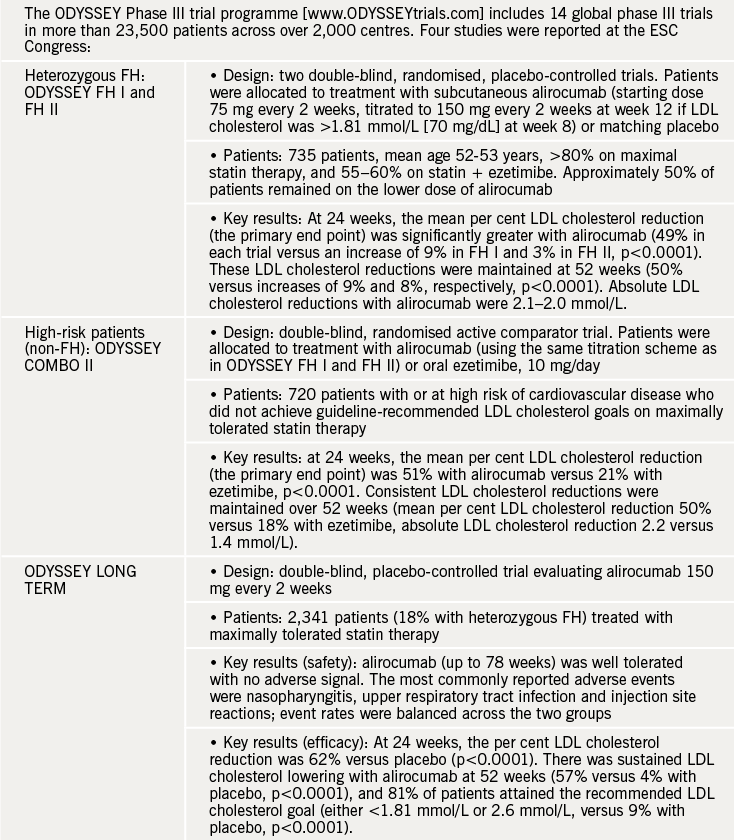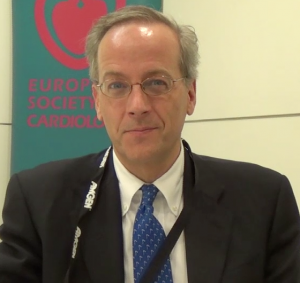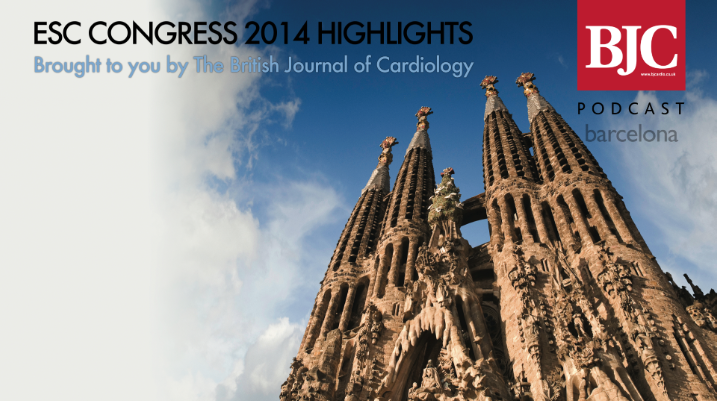News from lipid studies was a major topic at the European Society of Cardiology (ESC) 2014 Congress. The theme this year was ‘Innovation and the Heart’, reflecting progress in scientific discovery, clinical practice and technology with the ultimate aim of addressing unmet clinical needs in cardiovascular disease (CVD). According to Professor Keith Fox (University of Edinburgh) and Chair of the Congress Programme Committee: “ESC Congress aims to engage all countries in the fight against CVD. Although the clinical settings differ, the reality is that all countries face similar challenges.” Results from lipid studies presented at the meeting will help in this aim.
LDL debate
All guidelines agree that low-density lipoprotein cholesterol (LDL-C) is the primary lipid target, Irrespective of confusion following the publication of the American College of Cardiology/American Heart Association (ACC/AHA) guideline on cholesterol management,1 which is broadly similar to new NICE (National Institute for Health and Care Excellence) recommendations.2 But questions remain as to what is more relevant for reducing the risk of CVD: how you lower LDL-C or to what extent?
This issue was the focus of a hot debate between leading experts, at the symposium: ‘New frontiers in cholesterol management in high CV risk patients’, during the ESC Congress. Professor Jennifer G Robinson (University of Iowa, USA), one of the lead authors of the new ACC/AHA cholesterol guideline, supported the view that all that matters is how you lower LDL-C, arguing that there is no compelling evidence beyond the statin trials that other lipid-modifying interventions reduce CVD risk.

But countering this argument, Professor Kausik Ray (Division of Cardiovascular Sciences, St. Georges Hospital, University of London) emphasised that the extent to which LDL-C is lowered is critical. He cited evidence from population studies, genetic studies, as well as trials with diet, statins, bile acid sequestrants or ileal bypass surgery to support his argument. With respect to recent failures of trials of innovative lipid-modifying treatments such as dal-OUTCOMES and HPS2-THRIVE, he argued that it was bad trial design rather than the investigational treatment that was culpable. Professor Ray also addressed the issue of the safety of very low LDL-C levels, relevant in the context of treatments targeting PCSK9 (proprotein convertase subtilisin kexin 9), an important new primary target for lowering LDL-C.
More in depth discussion on lowering LDL-C to prevent CVD can be heard in our podcast from ESC. Professor Kausik Ray, Division of Cardiovascular Sciences, St. Georges Hospital, University of London, UK, believes the extent of LDL-C lowering, rather than the means of lowering LDL-C is key. He considers:
- Insights from genetic and observational studies
- Insights from clinical trials
- Are very low LDL-C levels safe?
Hotline II: coronary artery disease and lipids – good and bad news
PCSK9 was once again a hot topic in Barcelona, reflected by the inclusion of four trials from the ODYSSEY phase III programme with alirocumab, a fully human monoclonal antibody to PCSK9, in Hotline II. All four trials were in patients at high to very high risk of CVD, whose clinical needs were unmet with conventional lipid-lowering approaches: ODYSSEY FH I and FH II (in familial hypercholesterolaemia [FH]),3 ODYSSEY COMBO II (in high-risk patients with non-familial hypercholesterolaemia),4 and ODYSSEY LONG TERM (in both FH and non-FH patients).5 Overall, these trials add to the evidence-base for PCSK9 inhibitor treatment showing substantial sustained LDL-C lowering, together with no adverse signal. Key results are summarised in table 1.

The FH patient: underdiagnosed and undertreated
FH, a common genetic condition, now thought to affect between one in 200–250 people,6,7 represents a priority for treatment with PCSK9 monoclonal antibody therapy. Substantially increased levels of circulating atherogenic lipoproteins, including LDL-C and lipoprotein(a) [Lp(a)], result in an increased long-term atherosclerotic burden, unless patients are diagnosed and effective LDL-lowering treatment is instituted early. But FH is usually an incidental finding, either in the acute coronary care unit, or in the outpatient clinic, typically in older patients who present with chest pain, angina, dyslipidaemia and/or the inability to tolerate statins,as highlighted by Professor Kausik Ray, and discussed at the symposium: ‘The heterozygous FH patient: Who am I? Why do I matter to you?’.
In support, data from a Swiss study in 4,487 acute coronary syndrome (ACS) patients showed that around 17% had suspected FH based on clinical criteria; this estimate was even higher among those under 55 years (men) and 60 years (women).8 From the patient perspective, Katherine Wilemon (President of the FH Foundation) and herself an FH patient, emphasised that FH is not just a clinical condition but also a family condition, given that on average, recognition of one new FH patient leads to diagnosis of a further eight cases on cascade screening.
FH patients are difficult to treat with conventional therapies, with less than one in five achieving LDL-C levels <2.6 mmol/L (100 mg/dL) with statin-based approaches.9 Thus, PCSK9 inhibition represents a true ‘game changer’ in the management of FH patients, as discussed by Professor John Kastelein (Academic Medical Center, Amsterdam, the Netherlands) in the symposium: ‘Innovations in lipid management: evolving insights and implications from PCSK9’. The ODYSSEY FH I and FH II trials3, presented by Dr Michel Farnier (Point Medical, Dijon, France) add important new data. Treatment with alirocumab (75 mg every two weeks increasing to 150 mg every two weeks depending on LDL-C response) resulted in significant reduction in plasma LDL-C levels at 24 weeks (by 58% in ODYSSEY FH I and 51% in ODYSSEY FH II versus placebo, p<0.0001), with 72% and 81% of patients achieving guideline-recommended LDL-C goals (compared with 2% and 11% in the placebo groups). Importantly, the magnitude of LDL-C reduction was sustained at 52 weeks (see table 1).
Another patient priority: the very high risk patient
Patients at high CV risk are usually inadequately controlled on maximally tolerated statin therapy. As explained by the leading author of ODYSSEY COMBO II, Dr Christopher P Cannon (Harvard Clinical Research Institute, Boston, USA), this patient group includes the majority (>60%) of post-acute coronary syndrome (ACS) patients. Indeed, findings from the DYSIS (Dyslipidaemia International Study) I, presented by Dr Anselm Gitt (Herzzentrum Ludwigshafen, Germany), showed that only 21% of patients at very high risk of CVD (26,846 were in this category) attained the recommended LDL-C target of <1.8 mmol/L (70 mg/dL) on statin therapy.10 Interestingly, goal attainment in DYSIS was about two-fold higher in the UK than in Germany (80% versus 42% at an LDL-C goal <2.6 mmol/L). This may reflect the fact that in the UK, doctors are rewarded for achieving LDL-C targets, whereas in Germany, management is constrained by budget limitations.
In ODYSSEY COMBO II,4 720 high CV risk patients were randomised to receive either subcutaneous alirocumab (75-150 mg every two weeks) or oral ezetimibe (10 mg/day) for 104 weeks. At week 24, LDL-C levels were significantly reduced by alirocumab (51% versus 21% with ezetimibe) and 77% of patients achieved an LDL-C goal of <1.8 mmol/L compared with 46% on ezetimibe. Importantly, only 18% of patients required up-titration to the higher dose of alirocumab. Given potential concerns about treatment adherence with an injectable therapy, it is reassuring that 85% of patients were still on treatment by the end of the trial (table 1).
A hint in the right direction?

Finally, ODYSSEY LONG TERM,5 reported by Professor Jennifer Robinson (University of Iowa, Indiana, USA) showed an encouraging safety profile with alirocumab treatment (150 mg every two weeks) in 2,341 patients with hypercholesterolaemia at high to very high CV risk (18% with heterozygous FH) (see table 1). Added to evidence with evolocumab, another PCSK9 monoclonal antibody in advanced development, these findings indicate no new or emerging side effects with this therapy in more than 6,000 patients treated to date. However, what really generated excitement was a post hoc analysis using the same end point as in ODYSSEY OUTCOMES,11 suggesting a 54% decrease in major adverse CV events over the 65 week follow-up (hazard ratio 0.46, 95% confidence interval [CI] 0.26 to 0.82, absolute event rates 1.4% versus 3%, p<0.01). While ODYSSEY LONG TERM was not powered for analysis of clinical outcomes data, this result provides a reassuring hint in the right direction for this novel innovative LDL-C lowering treatment.
More discussion on the ODYSSEY trials, placing the studies in perspective, can be seen in our podcast where we talk to Dr Christopher P Cannon (Harvard Clinical Research Institute, Boston, Massachusetts USA). He considers:
- What was ODYSSEY COMBO II and what did it show?
- Were there any adherence issues given that the PCSK9 monoclonal antibody therapies are injected subcutaneously? Or any safety issues seen in the four trials?
- The FDA has asked for additional data on neurocognitive adverse effects. What does current evidence show?
- Finally, what do you see as the patient priorities for these treatments?
PCSK9: other news
A previous study had shown that plasma PCSK9 levels were predictive of CVD events in patients with coronary artery disease on statin treatment.12 Following on from this, a cohort study from the Karolinska Institutet, Stockholm, Sweden13 provided further support. In 4,232 men and women (aged 60 years at recruitment), 491 CVD events were reported over a 15-year follow-up period. Cox proportional Hazards modelling showed a 44% increased risk of new CVD events associated with higher serum PCSK9 levels (>122.3 ng/mL versus £122.3 ng/mL), which was only slightly attenuated by adjustment for conventional risk factors including lipids LDL-C, Lp(a), triglycerides and high-density lipoprotein cholesterol (HDL-C) (hazard ratio 1.30, 95% CI 1.04-1.61).
There was also news of another fully human PCSK9 monoclonal antibody therapy, RG7652, from the EQUATOR study, a proof of concept study in patients with or at high risk of coronary artery disease receiving statin therapy.14 Treatment with RG7652 (administered subcutaneously at doses of 200, 400 or 800 mg every eight weeks, 400 mg every four weeks or 800 mg every 12 weeks) was associated with dose-dependent reductions in LDL-C (by 48–60%, 56–74 mg/dL) relative to placebo. There was also a 33-39% reduction in Lp(a) at the two highest doses (400 mg every four weeks and 800 mg every eight weeks). These data warrant further clinical evaluation of this novel PCSK9 inhibitor therapy.
Disappointment for other lipid studies
News for other innovations was less welcome at the meeting. While the STABILITY (Stabilization of Atherosclerotic Plaque by Initiation of Darapladib Therapy) trial had suggested potential benefit on major coronary events with darapladib, a selective oral inhibitor of lipoprotein-associated phospholipase A2 (Lp-PLA2), on top of optimal therapy, the SOLID-TIMI 52 trial was negative.15,16
Briefly, SOLID-TIMI randomised 13,026 patients within 30 days of hospitalisation for an ACS. After a median duration of 2.5 years, treatment with darapladib (on top of best evidence-based treatment) resulted in no benefit on major coronary events (the primary end point); event rates were 16.3% versus 15.6% at three years (hazard ratio, 1.00 [95% CI 0.91-1.09]; p = 0.93). There was also no benefit on any other end points.
Principal investigator, Dr Michelle O’Donoghue (Brigham and Women’s Hospital, Boston, USA) argued that despite these negative findings, evidence continues to support a role for inflammation in atherosclerosis. Whether this lack of benefit may be at least partly explained by confounding due to the effects of statin therapy on Lp-PLA2 activity and mass, irrespective of LDL-C lowering, cannot be discounted. In his discussion of the study, Professor Robert M Califf (Duke University Medical Center, Durham, North Carolina, USA) considered that Lp-PLA2 may be a risk marker rather than a risk factor for CVD, analogous to current thinking for HDL-C.
The other disappointing major study was the STICS (Statin Therapy In Cardiac Surgery) trial, in which high-dose statin therapy, aiming to prevent inflammatory-mediated cardiac complications, failed to impact on development of new onset post-operative atrial fibrillation (AF) (see table 2).17 Thus, while high-dose statin therapy is effective in the long-term for reducing CVD events, treatment does not prevent post-operative complications. Discussant of the study, Professor Paulus Kirchoff (University of Birmingham) said that ESC guidelines18 may need to be reconsidered on the use of statin therapy perioperatively which is currently recommended.

Statins: a role in STEMI?
Imaging trials have clearly shown that statins either stabilise or even decrease the progression of atherosclerotic plaque in patients with stable coronary artery disease. Statin treatment has also been shown to have favourable impact on plaque composition, decreasing the lipid burden and increasing the fibrous content of the plaque.19,20 However, questions remain about the role of statins in ST-segment elevation myocardial infarction (STEMI) ACS, given that imaging trials have generally excluded such patients, due to their higher risk for recurrent events and high frequency of vulnerable plaques beyond the culprit lesion. This was addressed by the Integrated Biomarker Imaging Study (IBIS-4), nested within the COMFORTABLE-AMI study, and presented at ESC Congress Hotline V.21
IBIS-4 included 103 STEMI patients treated with rosuvastatin (20 mg/day for two weeks, uptitrated to 40 mg/day long-term) who underwent intravascular ultrasound (IVUS) and radiofrequency ultrasound of the two non–infarct-related coronary arteries following successful primary percutaneous coronary intervention. After 13 months, high-dose rosuvastatin therapy was associated with significant reduction in the primary IVUS end point, the per cent atheroma volume in the non–infarct-related arteries (decrease from baseline, -0.9%, 95% CI -1.56 to -0.25, p=0.007). There was no change in the per cent necrotic core between baseline and follow-up and no improvement in lesion phenotype. Whether the lack of benefit on plaque composition may be due to limitations in IVUS sensitivity is a matter for conjecture. Irrespective of this finding, it should be emphasised that IBIS-4 confirmed the benefit of long-term, high-dose statin therapy on plaque in STEMI patients.
Other news
Are we treating patients too late?
Atherosclerosis is a chronic and progressive inflammatory condition that remains asymptomatic for decades. This raises a critical question: should we be more proactive in our approach to management, targeting treatment earlier to prevent clinical disease? That was the question posed by Dr Ann Marie Navar-Boggan (Duke University, Durham, North Carolina, USA) in the rapid fire session: ‘Struggles with the lipid guidelines in clinical practice’.22 Most adults recommended for statin therapy are older. However, modelling analysis based on the Framingham Heart Study (for individuals free of CVD at age 55 years) showed that there was a 21% increase in CHD risk per 10 mg/dL increase in average non-HDL-C, after adjustment for differences in rates of diabetes. Thus, while application of recent guidelines in the US and UK may increase the total number of people recommended for statin therapy, this has the potential for benefit in terms of decreasing the burden of CVD.
Update on the Guidelines
Finally, there comes news of a planned review of the ESC/European Atherosclerosis Society (EAS) guidelines for dyslipidaemia management to update them. Speaking at the session: ‘Risk factor reduction in CAD: do we require different strategies in developing countries’, Professor Alberico L Catapano President of the EAS (University of Milan and Multimedica IRCCS, Italy) commented on future challenges for the guidelines: “Questions to be considered include moving to lifetime risk in CVD risk assessment; the relevance of apolipoproteins versus lipids; pe rcent reduction versus targets; and early versus intensive treatment – or both?” Clearly such issues are critical to address the escalating burden of CVD; in the UK, CVD costs are estimated to reach €23.1 billion by 2020.23 Revision of the guidelines will commence in October 2014 with completion planned by October 2015.
More reports from ESC
If you want to find out more from the ESC, read our report highlighting major studies, and watch our podcasts from the Congress.
References
1. Stone NJ, Robinson J, Lichtenstein AH et al. 2013 ACC/AHA guideline on the treatment of blood cholesterol to reduce atherosclerotic cardiovascular risk in adults: a report of the American College of Cardiology/American Heart Association Task Force on Practice Guidelines. J Am Coll Cardiol 2014;63(25 Pt B):2889–934. http://dx.doi.org/10.1161/01.cir.0000437738.63853.7a
2. NICE. Lipid modification: cardiovascular risk assessment and the modification of blood lipids for the primary and secondary prevention of cardiovascular disease. NICE guidelines [CG181], July 2014. Available at: http://www.nice.org.uk/Guidance/CG181.
3. Kastelein JJP, Ginsberg HN, Langslet G, et al. Efficacy and safety of alirocumab in patients with heterozygous familial hypercholesterolaemia (heFH) not adequately controlled with current lipid-lowering therapy: Results of the ODYSSEY FH 1 and FH II studies. ESC Congress, Hotline II. 31 August, 2014 [Abstract 2125].
4. Cannon CP, Cariou B, Blom D, et al. Efficacy and safety of alirocumab in high cardiovascular risk patients with inadequately controlled hypercholesterolaemia on maximally tolerated daily statin: results from the ODYSSEY COMBO II study. ESC Congress, Hotline II. 31 August, 2014 [Abstract 2123].
5. Robinson JG, Farnier M, Krempf M, et al. Long-term safety, tolerability and efficacy of alirocumab versusplacebo in high cardiovascular risk patients: first results from the ODYSSEY LONG TERM study in 2,341 patients. ESC Congress, Hotline II. 31 August, 2014.
6. Sjouke B, Kusters DM, Kindt I, et al. Homozygous autosomal dominant hypercholesterolaemia in the Netherlands: prevalence, genotype-phenotype relationship, and clinical outcome. Eur Heart J 2014 Feb 28. http://dx.doi.org/10.1093/eurheartj/ehu058
7. Nordestgaard BG, Chapman MJ, Humphries SE et al. Familial hypercholesterolaemia is underdiagnosed and undertreated in the general population: guidance for clinicians to prevent coronary heart disease: consensus statement of the European Atherosclerosis Society. Eur Heart J 2013;34:3478-90a. http://dx.doi.org/10.1093/eurheartj/eht273
8. Nanchen D, Gencer B, Auer R et al. Prevalence of familial hypercholesterolaemia and cardiovascular risk management among patients with acute coronary syndromes: a prospective Swiss study. ESC Congress, 1 September 2014 [Abstract 3824].
9. Pijlman AH, Huijgen R, Verhagen SN et al. Evaluation of cholesterol lowering treatment of patients with familial hypercholesterolemia: a large cross-sectional study in The Netherlands. Atherosclerosis 2010;209:189-94. http://dx.doi.org/10.1016/j.atherosclerosis.2009.09.014
10. Gitt AK, Ambegaonkar B, Brudi P et al. Statin-treated patients at very high cardiovascular risk: are the majority close to LDL-C <70 mg/dL? ESC Congress, 1 September 2014 [Abstract 3819].
11. ODYSSEY OUTCOMES: Evaluation of Cardiovascular Outcomes After an Acute Coronary Syndrome During Treatment With Alirocumab SAR236553 (REGN727). Available at: http://clinicaltrials.gov/show/NCT01663402
12. Werner C, Hoffmann MM, Winkler K, Böhm M, Laufs U. Risk prediction with proprotein convertase subtilisin/kexin type 9 (PCSK9) in patients with stable coronary disease on statin treatment. Vascul Pharmacol 2014;62:94-102. http://dx.doi.org/10.1016/j.vph.2014.03.004
13. Leander K, Malarstig A, Van T Hooft FM et al. Circulating PCSK9 predicts future risk of cardiovascular events independently of established risk factors. ESC Congress, 1 September 2014, Poster P2104.
14. Tingley WG, Mosesova S, Baruch A et al. Effects of RG7652, a monoclonal antibody against proprotein convertase subtilisin kexin 9, on low-density lipoprotein cholesterol in patients with coronary artery disease or high risk: results from the EQUATOR study. ESC Congress, 1 September 2014, Poster P2105.
15. The STABILITY Investigators, White HD, Held C, Stewart R et al. Darapladib for preventing ischemic events in stable coronary heart disease. N Engl J Med 2014; 370:1702-11. http://dx.doi.org/10.1056/NEJMoa1315878
16. O’Donoghue ML, Braunwald E, White HD et al. Effect of darapladib on major coronary events after an acute coronary syndrome. The SOLID-TIMI 52 randomized clinical trial. JAMA 2014. http://dx.doi.org/10.1001/jama.2014.11061. Published online August 31, 2014.
17. Casadei B et al. Perioperative statin treatment in cardiac surgery for the prevention of atrial fibrillation and perioperative myocardial damage: the Statin Therapy in Cardiac Surgery (STICS) trial. ESC Congress, Hotline V. 2 September 2014 [Abstract 4943].
18. Camm AJ1, Lip GY, De Caterina R et al. 2012 focused update of the ESC Guidelines for the management of atrial fibrillation: an update of the 2010 ESC Guidelines for the management of atrial fibrillation. Developed with the special contribution of the European Heart Rhythm Association. Eur Heart J 2012;33:2719-47. http://dx.doi.org/10.1093/eurheartj/ehq278
19. Kawasaki M, Sano K, Okubo M. Volumetric quantitative analysis of tissue characteristics of coronary plaques after statin therapy using three-dimensional integrated backscatter intravascular ultrasound. J Am Coll Cardiol 2005;45:1946–53. http://dx.doi.org/10.1016/j.jacc.2004.09.081
20. Sano K, Kawasaki M, Ishihara Y. Assessment of vulnerable plaques causing acute coronary syndrome using integrated backscatter intravascular ultrasound. J Am Coll Cardiol 2006; 47:734–41. http://dx.doi.org/10.1016/j.jacc.2005.09.061
21. Räber L, Taniwaki M, Zaugg S et al. Effect of high-intensity statin therapy on atherosclerosis in non-infarct-related coronary arteries (IBIS-4): a serial intravascular ultrasonography study. Eur Heart J 2014 Sep 2. pii: ehu373. [Epub ahead of print].
22. Navar-Boggan AM, Peterson ED, D’Agostino RB et al. Future risk of coronary heart disease due to uncontrolled hyperlipidemia in early adulthood. ESC Congress 1 September, 2014 Abstract 3823.
23. PharmaTimes. CVD estimated costs. Available at: http://www.pharmatimes.com/Article/14-08-31/UK_CVD_costs_to_reach_%E2%82%AC23_1_billion_by_2020_study.aspx. Accessed 19 September, 2014.


